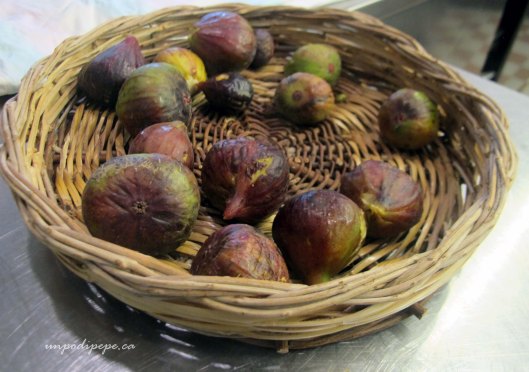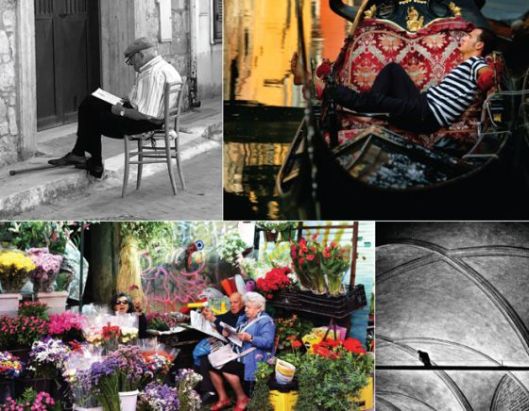Tags
Barrel vaulted ceiling, Cucina Pugliese, Fiori di zucca, In my kitchen, Mozzarella di bufala, Orsarosa, Parmigiana di melanzane, Pugliese Traditions, Ravioli
 I recently returned from 6 weeks at our little casa in Orsara di Puglia. As usual, there was a lot of activity in the kitchen. Cucina povera, literally ‘food of the poor’, is what you will mostly find in Puglia. Simple foods made with fresh local ingredients. Here are just a few of the things my family and I were up to in our tiny but functional summer kitchen in Orsara di Puglia. Since I have so much material to write about, I have kept it to gifts of food received from amici, parenti e vicini di casa -friends, relatives and neighbours.
I recently returned from 6 weeks at our little casa in Orsara di Puglia. As usual, there was a lot of activity in the kitchen. Cucina povera, literally ‘food of the poor’, is what you will mostly find in Puglia. Simple foods made with fresh local ingredients. Here are just a few of the things my family and I were up to in our tiny but functional summer kitchen in Orsara di Puglia. Since I have so much material to write about, I have kept it to gifts of food received from amici, parenti e vicini di casa -friends, relatives and neighbours.
About the space, the whole place is only 40m² (about 450 square feet) including a bedroom and bathroom. That is about the size of a double garage. The room with the cucina is also the living room, guest room (aka my room) and art studio. The highlight of the room is the amazing barrel vaulted stone ceiling, which is hard to fit in a photo. There is even the face of a Madonnina on one of the stones. We had a lot of visitors, many who came bearing gifts. This lovely cestino, filled with locally grown vegetables was dropped off by one of our neighbours.
We had a lot of visitors, many who came bearing gifts. This lovely cestino, filled with locally grown vegetables was dropped off by one of our neighbours. 
The melanzane (eggplant, or aubergine for the Brits) were stuffed and baked. The pulp was fried up with a bit of ground beef and pork, garlic, breadcrumbs and parmigiano, then stuffed and topped with tomato sauce and mozzarella. They were soooo yummy, but we only made them once, as it was so hot that having the oven on was painful! The long green and red peperoni or peppers in the cestino are called friarill’. They are sweet tasting, and as the name implies, are usually fried. Friarill’ on fresh bread taste heavenly!
The long green and red peperoni or peppers in the cestino are called friarill’. They are sweet tasting, and as the name implies, are usually fried. Friarill’ on fresh bread taste heavenly! The gift of fresh eggs is amazing. I used half of them to make fresh egg pasta for ravioli di ricotta e spinaci. I froze them for the festa della Madonna della Neve Aug 5th. Freezing them was hard, as the freezer is so tiny. I make these often in Vancouver, and they are good-but the goat milk ricotta here is so incredibly good that they taste better.
The gift of fresh eggs is amazing. I used half of them to make fresh egg pasta for ravioli di ricotta e spinaci. I froze them for the festa della Madonna della Neve Aug 5th. Freezing them was hard, as the freezer is so tiny. I make these often in Vancouver, and they are good-but the goat milk ricotta here is so incredibly good that they taste better. I was happy to use my spianatoia one more time. That is the wooden pasta rolling board. It has a lip on one end so it stays put on the table and a handy carrying handle, just like the chair.
I was happy to use my spianatoia one more time. That is the wooden pasta rolling board. It has a lip on one end so it stays put on the table and a handy carrying handle, just like the chair.
Mamma and I used the rest of the eggs to make Torta di mela, an apple cake. We made it to bring to our family grigliata -BBQ- at the olive grove that was my Nonno’s. It had to be baked at 1 am as it was just too painful to turn the oven on during the day. La torta looked a bit plain, so I placed a clean crochet doily over the top and sprinkled icing sugar all over. The fancy shmancy design was left on the cake. I often have to do this to my Torta Caprese because the top always collapses a bit.
La torta looked a bit plain, so I placed a clean crochet doily over the top and sprinkled icing sugar all over. The fancy shmancy design was left on the cake. I often have to do this to my Torta Caprese because the top always collapses a bit.  Fiori di zucca are one of my favourite summer foods-and my favourite bouquet of flowers. My Zio brought over a LOT of them one day, an hour before we were going to be eating. I stuffed some of them with what I had available. There were a few trecce-fresh, braided mozzarella, in the fridge and basilico growing out on the tiny terrazza. Once they were stuffed, I battered them in flour and mineral water with a few bonus ingredients like parmigiano and basilico, and then fried them.
Fiori di zucca are one of my favourite summer foods-and my favourite bouquet of flowers. My Zio brought over a LOT of them one day, an hour before we were going to be eating. I stuffed some of them with what I had available. There were a few trecce-fresh, braided mozzarella, in the fridge and basilico growing out on the tiny terrazza. Once they were stuffed, I battered them in flour and mineral water with a few bonus ingredients like parmigiano and basilico, and then fried them. 
They were crunchy and delicious, but I only had time to use up less than half of my precious fiori.  Fiori di zucca are extremely delicate. They only last a day 2 and do not freeze well. Not wanting to waste them, once I finished the dishes, I drizzled olive oil on a baking pan, borrowed some caciocavallo from my neighbour, and stuffed a bunch more. The stuffed fiori were placed in the pan, which went straight into the freezer to use a 4 days later. Great idea, no? Well-yes and no. They had to be baked, since attempting to fry these beauties after freezing would turn them into mush. Baking them at 1am was not an option. We had to endure the heat but they were worth the sweat!
Fiori di zucca are extremely delicate. They only last a day 2 and do not freeze well. Not wanting to waste them, once I finished the dishes, I drizzled olive oil on a baking pan, borrowed some caciocavallo from my neighbour, and stuffed a bunch more. The stuffed fiori were placed in the pan, which went straight into the freezer to use a 4 days later. Great idea, no? Well-yes and no. They had to be baked, since attempting to fry these beauties after freezing would turn them into mush. Baking them at 1am was not an option. We had to endure the heat but they were worth the sweat! A few fiori were saved to make risotto the next day. This was a new thing for me, as I have never had so many fiori that I could make risotto. More recipe ideas and harvesting tips can be found in the post Fiori di zucca.
A few fiori were saved to make risotto the next day. This was a new thing for me, as I have never had so many fiori that I could make risotto. More recipe ideas and harvesting tips can be found in the post Fiori di zucca.  My amico Peppe Zullo gave me a few bottles of his vino rosato Amarosa. Apparently the name Amarosa has been trademarked by someone else, so the vino is getting a name change. It will now be named after Orsara’s women’s soccer (or football for the Brits) team….Orsarosa!
My amico Peppe Zullo gave me a few bottles of his vino rosato Amarosa. Apparently the name Amarosa has been trademarked by someone else, so the vino is getting a name change. It will now be named after Orsara’s women’s soccer (or football for the Brits) team….Orsarosa! Mercoledi/Wednesday is mozzarella di bufala day. I came home from Procida on a Thursday and a friend had left me these melt in your mouth ones. They are from Masseria Li Gatti near Torremaggiore, SanSevero (FG).
Mercoledi/Wednesday is mozzarella di bufala day. I came home from Procida on a Thursday and a friend had left me these melt in your mouth ones. They are from Masseria Li Gatti near Torremaggiore, SanSevero (FG).  The mozzarella are in the new Pugliese serving bowls my sister brought from Polignano a Mare. The piattaia is full so I will need to find somewhere to display them.
The mozzarella are in the new Pugliese serving bowls my sister brought from Polignano a Mare. The piattaia is full so I will need to find somewhere to display them. I hope this post has made you either hungry and drooling or wishing you could visit Puglia yourself. Perhaps it has done both? Perché no? I am already planning my next visit! Buon appetito e buon viaggio, Cristina
I hope this post has made you either hungry and drooling or wishing you could visit Puglia yourself. Perhaps it has done both? Perché no? I am already planning my next visit! Buon appetito e buon viaggio, Cristina
Thanks Sherry from Australia for hosting the monthly food blogging event, In My Kitchen (IMK). Click the link to Sherry’s Pickings to read about other world kitchens this month. Buon appetito, Cristina





























































 I hope this post has made you either hungry and drooling or wishing you could visit Puglia yourself. Maybe it has done both? Buon appetito e buon viaggio, Cristina
I hope this post has made you either hungry and drooling or wishing you could visit Puglia yourself. Maybe it has done both? Buon appetito e buon viaggio, Cristina










































